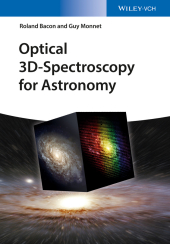 Neuerscheinungen 2017Stand: 2020-02-01 |
Schnellsuche
ISBN/Stichwort/Autor
|
Herderstraße 10
10625 Berlin
Tel.: 030 315 714 16
Fax 030 315 714 14
info@buchspektrum.de |

Roland Bacon, Guy Monnet
(Beteiligte)
Optical 3D-Spectroscopy for Astronomy
2017. XIV, 276 S. w. 122 figs. (97 col.). 24,5 cm
Verlag/Jahr: WILEY-VCH 2017
ISBN: 3-527-41202-6 (3527412026)
Neue ISBN: 978-3-527-41202-0 (9783527412020)
Preis und Lieferzeit: Bitte klicken
DAS Referenzwerk mit aktuellen Informationen zu 3D-Spektrographen, die bei astronomischen Beobachtungen weit verbreitet sind, beschäftigt sich mit Licht im sichtbaren Nah-Infrarot- und Nah-UV-Bereich, erläutert die besten Beobachtungsstrategien und Instrumente und zeigt, wie die erzielten Daten verwaltet werden.
Over the last 50 years, a variety of techniques have been developed to add a third dimension to regular imaging, with an extended spectrum associated to every imaging pixel. Dubbed 3D spectroscopy from its data format, it is now widely used in the astrophysical domain, but also inter alia for atmospheric sciences and remote sensing purposes.
This is the first book to comprehensively tackle these new capabilities. It starts with the fundamentals of spectroscopic instruments, in particular their potentials and limits. It then reviews the various known 3D techniques, with particular emphasis on pinpointing their different `ecological? niches. Putative users are finally led through the whole observing process, from observation planning to the extensive ? and crucial - phase of data reduction. This book overall goal is to give the non-specialist enough hands-on knowledge to learn fast how to properly use and produce meaningful data when using such a 3D capability.
1 Introduction
Part 1: 3D Instrumentation
2 The Spectroscopic Toolbox
2.1 Basic Spectroscopic Principles
2.2 Optics & Coatings
2.3 Detectors
2.4 Interferometers
2.5 Dispersers
2.6 Mechanics & Cryogenics, Electronics
2.7 Management, Timeline & Cost
2.8 Exercises
3 Scanning Spectrographs
3.1 Scanning Long--Slit Spectrograph
3.2 Scanning Fabry--Perot Spectrograph
3.3 Scanning Fourier Transform Spectrograph
3.4 Exercises
4 Integral Field Spectrographs
4.1 Lenslet--based Integral Field Spectrograph
4.2 Fiber--based Integral Field Spectrograph
4.3 Slicer--based Integral Field Spectrograph
4.4 Exercises
5 New Trends in Integral Field Spectroscopy
5.1 Deployable Multi--object Integral Field Spectrograph
5.2 Paving the Field: parallel replicated Instruments
5.3 An Example: Autopsy of the MUSE wide--field Spectrograph
5.4 Exercises
6 Future Trends in 3D Spectroscopy
6.1 Photonics--based Spectrographs
6.2 Quest for the Grail: towards 3D Detectors
6.3 Exercises
Part 2: Using 3D Spectroscopy
7 Data Properties
7.1 Data Sampling
7.2 Noise Properties
8 Impact of Atmospheric Turbulence
8.1 Basic Principles
8.2 Seeing--limited Observations
8.3 Adaptive Optics Observations
8.4 Space--based Observations
9 Data Gathering
9.1 Planning Observations
9.2 Estimating Observing Time
9.3 Observing Strategy
10 Data Reduction
10.1 Basics
10.2 Specific Cases
11 Data Analysis
11.1 Kinematics
11.2 Spectrophotometry
11.3 Crowded Fields
11.4 Faint Point--like Sources
11.5 Faint Surface brightness Sources
11.6 Spatial Deconvolution
11.7 High Contrast Imaging
12 Conclusions
Bibliography
Annex 1: Hints to Exercises


